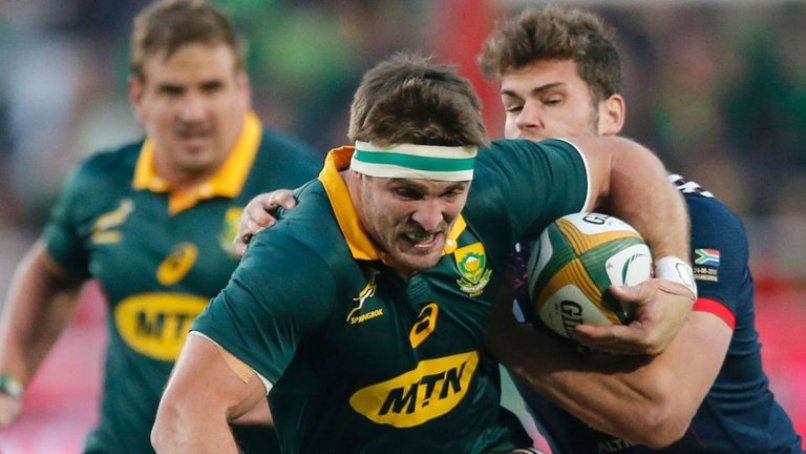 Reflecting rugby’s unwavering commitment to embracing and incorporating the latest brain health science and technology, World Rugby, New Zealand Rugby (NZR) and Rugby Australia (RA) have partnered with NeuroFlex® to run an in-match trial during the 2021 Super Rugby Trans-Tasman competition.
Reflecting rugby’s unwavering commitment to embracing and incorporating the latest brain health science and technology, World Rugby, New Zealand Rugby (NZR) and Rugby Australia (RA) have partnered with NeuroFlex® to run an in-match trial during the 2021 Super Rugby Trans-Tasman competition.
The NeuroFlex® VR test is based on a set of scientifically validated oculomotor functions. Within seconds, the NeuroFlex® software analyses the test data with its proprietary algorithms to generate an accurate, quantitative and metrics-based report which provides objective data for medical personal to diagnose and manage concussions.
Used for the first time during the opening round of Super Rugby Trans-Tasman matches, the technology is being used alongside the current Head Injury Assessment (HIA) protocols to objectively determine whether the eye-tracking system could further enhance the HIA process, currently operating at 90 per cent accuracy in elite competitions. This innovative way to identify altered oculomotor function and head movement will also be used within the six-stage graduated return-to-play process to monitor players returning from injury and protect their health.
Download Dr. Éanna Falvey’s video >>
The NeuroFlex® eye-tracking technology is an objective test that could further improve rugby’s approach to brain health, supporting doctors to make the right decision. Numerous scientific studies have demonstrated that oculomotor functions are altered at the time of, or shortly after a concussion[1] and the ground-breaking trial aims to verify the test’s diagnostic accuracy.
In the lead-up to Super Rugby Trans-Tasman, teams have been embracing the study with all participating players undertaking baseline testing under controlled conditions to provide an accurate comparison for use when a player comes off the field for an HIA.
Data collected from the NeuroFlex® VR testing will be used to compare the accuracy of concussion identification based on the eye and head movements versus the current iteration of the HIA. The trial’s outcomes will inform future moves that the sport will take in advancing the welfare of players.
World Rugby Chief Medical Officer Dr Éanna Falvey said: “As a key element of our progressive approach to injury reduction and management, rugby continually explores and assesses technology developments that could enhance the care of players in our sport, from community rugby to the elite competitions.
“We believe that oculomotor screening examination in rugby has the potential to boost the identification and management of concussions by objectively identifying potential abnormalities in oculomotor function between a player’s baseline and when removed for an HIA assessment, adding to the depth of identification methods available to the sport.
“We are excited about this work and would like to thank New Zealand Rugby and Rugby Australia for embracing it. The ambition of this partnership with NeuroFlex® is to determine the technology’s objective diagnostic accuracy in a rugby environment and help inform the advancement of World Rugby’s future concussion identification and management strategies.”
For NZR and RA, the opportunity to participate in a ground-breaking trial aligns with rugby’s collective commitment to not stand still when it comes to furthering the accuracy of the tools available to aid detection, management and prevention of concussion.
Rugby AU Chief Medical Officer Warren McDonald said: “This trial is another step in our continual quest to improve the assessment and management of concussion. Eye tracking is a mode that has the potential to enhance the accuracy of our assessment. Rugby AU appreciates the enthusiastic support from all stakeholders in the implementation of this trial to benefit the welfare of players.”
NZR Medical Manager People, Safety and Wellbeing Karen Rasmussen said: “NZR is committed to doing all we can to improve the safety and injury management of our players and the opportunity to explore new technology that might allow us to enhance the HIA process for the benefit of current and future players was something we wanted to be part of. Players, coaches and team management have been hugely supportive of the trial and we’d like to thank them for working with us on what we see is an important player welfare initiative.”
International Rugby Players Head of Player Welfare Conrad Smith said: “This development has real potential and it’s great to see it rolled out in the Trans-Tasman competition. It’s important that we use advances in technology to further our understanding of brain health and head injuries in our sport.”
Said Isabel Galiana, CEO of Saccade Analytics, developer of NeuroFlex® said: “We are so pleased to support World Rugby in providing cutting edge technologies to their elite players and indeed players at all levels. NeuroFlex® provides objective, actionable data on brain functionality by using eye-tracking software in virtual reality. We are particularly excited because NeuroFlex® can support player welfare beyond HIA1 to facilitate unbiased return-to-play decisions through oculomotor rehabilitation and HIA2 and HIA3 screening.”
Underscoring the continued commitment to furthering head injury prevention in rugby using the latest available technology, World Rugby is also partnering with NZR, the University of Otago and Prevent Biometrics to undertake the largest-ever study, led on the ground by NZR Research Scientist Dr Danielle Salmon, to understand the nature and frequency of head impacts in men’s and women’s community and age-grade rugby, using instrumented mouthguards. – WORLD RUGBY
































